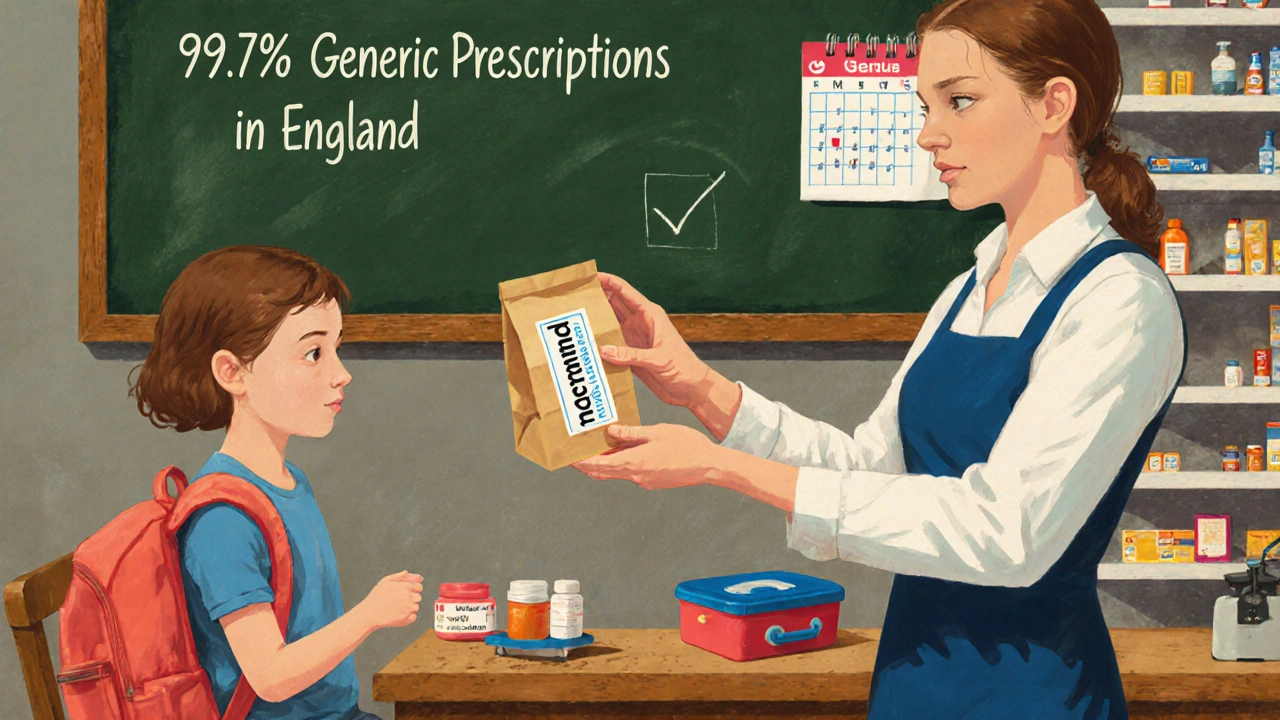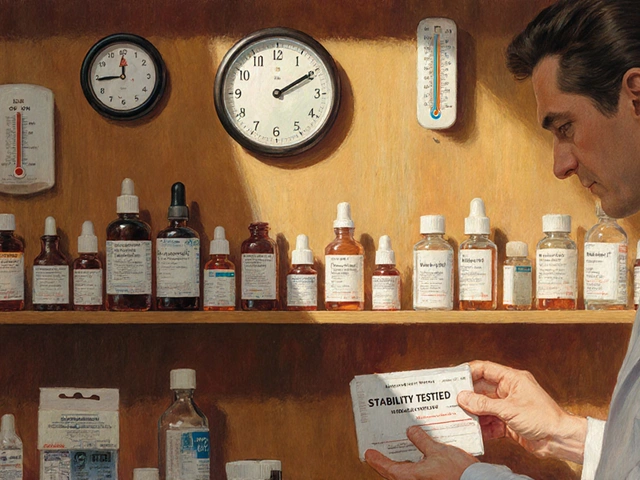When you write a prescription, you’re not just choosing a drug-you’re choosing a system. The difference between writing atorvastatin and Lipitor might seem small, but it carries real weight: cost, safety, adherence, and even trust. Generic prescribing isn’t a cost-cutting trick. It’s a well-researched, evidence-backed standard that saves lives and money-when done right.
What Generic Prescribing Actually Means
Generic prescribing means writing prescriptions using the International Non-proprietary Name (INN) of a drug-the active ingredient-instead of the brand name. So you write metformin, not Glucophage; sertraline, not Zoloft. This isn’t new. The World Health Organization started standardizing these names back in 1950 to cut through the confusion of hundreds of brand names for the same chemical. In the UK, the NHS pushed hard for this in the 1990s. Today, 89.7% of prescriptions in England are issued generically. That’s not because doctors are being forced to-it’s because the data shows it works. Generic drugs cost 80-85% less than their branded versions. Atorvastatin? £2.50 a month instead of £30. Omeprazole? £1.80 instead of £15. That’s not a rounding error. That’s thousands of pounds saved per patient over a year. But here’s the catch: generics aren’t cheaper because they’re worse. They’re cheaper because they don’t carry the marketing, advertising, and patent protection costs. The active ingredient? Identical. The dosage form? The same. The purity and potency? Regulated to the same standard by the MHRA, FDA, and EMA. Every generic must prove it’s bioequivalent-meaning it delivers the same amount of drug into the bloodstream within an acceptable range (80-125% of the brand). That’s not a suggestion. It’s a legal requirement.When Brand Names Still Matter
Not every drug should be prescribed generically. There are real, clinically meaningful exceptions. The British National Formulary (BNF) clearly defines three categories where brand-name prescribing is recommended:- Category 1: Narrow therapeutic index drugs-where tiny differences in blood levels can cause harm or treatment failure. Think warfarin, levothyroxine, phenytoin, carbamazepine, and digoxin. A 5% shift in absorption might mean a dangerous INR spike or a missed seizure threshold.
- Category 2: Modified-release formulations-like theophylline or certain sustained-release opioids. These rely on precise coating or matrix systems to release the drug slowly. Generic versions may use different technologies, leading to inconsistent absorption. Pharmacists report this is one of the most common points of confusion in community pharmacies.
- Category 3: Biologics and biosimilars-insulin, infliximab, adalimumab, etanercept. These are complex molecules made from living cells. The MHRA explicitly states these must be prescribed by brand name. Why? Because switching between originator and biosimilar can trigger immune reactions. No two biosimilars are identical in structure, even if they’re approved as equivalent.
Why Generic Prescribing Improves Outcomes
It’s not just about saving money. It’s about helping people take their meds. A 2017 JAMA study showed patients on generic medications were 15% less likely to be hospitalized for chronic conditions like hypertension or diabetes. Why? Because cost is the biggest barrier to adherence. If a patient has to choose between their blood pressure pill and their groceries, they’ll skip the pill. Generic prescribing removes that choice. The American College of Physicians found generic prescribing improved medication adherence by 8-12%. That’s not a marginal gain. That’s the difference between a patient controlling their diabetes and ending up in the ER with a foot ulcer. And here’s something most people don’t realize: generic prescribing reduces medication errors. Imagine a patient on five different drugs. Each has three brand names across different countries. Now imagine a nurse or pharmacist trying to match them up. With generic names, there’s one name per active ingredient. The Institute for Safe Medication Practices found this cuts prescribing errors by 50%.
What Doctors Are Really Thinking
A 2022 NHS survey of 12,500 GPs found 78% strongly agreed that generic prescribing reduces costs without compromising care. But 34% still worried about patient pushback. And that’s the real challenge-not science, but perception. Patients hear “generic” and think “cheaper,” “weaker,” “second-rate.” That’s the nocebo effect in action. A 2021 study in Patient Education and Counseling showed that when doctors explained why they were prescribing a generic-“This has the same active ingredient, tested to work the same way, and saves you £12 a month”-patient acceptance jumped from 67% to 89%. One family doctor on Reddit summed it up: “95% of my patients do fine with generics. The 5% who have issues? Usually it’s levothyroxine or sertraline. I don’t switch them unless they ask. And I always check in.” That’s the key: it’s not about blanket substitution. It’s about informed, individualized care.How to Implement This in Practice
You don’t need a revolution. You need a system. The NHS Generic Prescribing Toolkit (2023) outlines a clear four-step approach:- Audit your prescribing. Use the NHS Prescribing Analytics Dashboard. See where you’re still prescribing brands unnecessarily.
- Know the exceptions. Keep the BNF’s three-category list handy. Bookmark it. Print it. Put it on your screen. You won’t remember all 50+ exceptions, but you’ll remember the big ones if you’re reminded.
- Set defaults in your e-prescribing system. Most systems now let you set generic as the default. Turn it on. Only override when clinically necessary.
- Monitor and review. Check your monthly prescribing reports. Are you hitting 90%+? If not, look at your outliers. Are you prescribing brand-name metformin? Why?
What to Say to Patients
You don’t need to be a pharmacist to explain this. Use simple, direct language:- “This medicine has the same active ingredient as the brand you were on. It’s been tested to work the same way.”
- “It’s much cheaper-about £12 a month less. That’s £144 a year saved.”
- “I’ve prescribed this for hundreds of patients. It works just as well.”
- “If you notice any changes-like feeling different, or your symptoms coming back-let me know. We can switch back.”

The Bigger Picture
The global generic drug market is worth over $438 billion. In the US, generics make up 90% of prescriptions but only 15% of drug spending. In the NHS, 89.7% of prescriptions are generic-but they account for just 26% of total drug costs. That’s the power of this approach. But the future isn’t just about more generics. It’s about smarter substitution. The NHS is moving toward “intelligent substitution”-using real-world data to identify which patients can safely switch and which need brand continuity. For example, a patient on a stable dose of levothyroxine for five years? Don’t switch. A new patient starting on sertraline? Start with the generic. The goal isn’t to eliminate brand names. It’s to use them wisely. When a drug truly needs consistency-like a biologic or a narrow therapeutic index medicine-prescribe the brand. Otherwise, prescribe the generic. It’s not just good policy. It’s good medicine.Common Myths Debunked
- Myth: Generics are made in lower-quality factories. Fact: The same factories often make both brand and generic versions. The MHRA inspects them all to the same standard.
- Myth: Generics take longer to work. Fact: Bioequivalence testing proves absorption rates are within 10% of the brand. No meaningful delay.
- Myth: Patients feel worse on generics. Fact: Most reports of “worse effects” disappear when patients are told they’re getting the same drug. The nocebo effect is powerful.
- Myth: All generics are the same. Fact: Different manufacturers use different fillers and coatings. That’s why switching between generic brands can sometimes cause issues-especially with modified-release drugs. Stick to one generic unless there’s a reason to change.
Are generic drugs as safe as brand-name drugs?
Yes. Generic drugs must meet the same strict standards for quality, purity, strength, and performance as brand-name drugs. The MHRA, FDA, and EMA require each generic to prove it delivers the same amount of active ingredient into the bloodstream at the same rate as the original. Any generic that fails this test is rejected. There is no difference in safety profile when used as directed.
Why do some patients say generics don’t work for them?
In most cases, it’s not the drug-it’s the expectation. Studies show that when patients believe generics are inferior, they’re more likely to report side effects or reduced effectiveness-even when there’s no clinical difference. This is called the nocebo effect. When doctors explain that the active ingredient is identical and the medicine is rigorously tested, patient concerns drop by more than 20%. For a small group with narrow therapeutic index drugs like levothyroxine or warfarin, switching between different generic manufacturers can cause measurable changes. That’s why consistency matters in those cases.
Can pharmacists substitute a generic without my permission?
In the UK, pharmacists can substitute a generic unless the prescription specifically says “dispense as written” or the drug is on the NHS’s list of exceptions (like levothyroxine or warfarin). If you’re concerned, ask your doctor to write “Do not substitute” on the prescription. This is common for patients on antiepileptics or complex biologics. Always check with your pharmacist if you notice a change in your medication’s appearance or packaging.
Are there any drugs that don’t have generic versions yet?
Yes. Newer drugs, especially biologics like Humira or Enbrel, are still under patent protection and don’t have generics. However, biosimilars-highly similar versions-are now available for many of these. Unlike small-molecule generics, biosimilars must be prescribed by brand name to ensure the same product is dispensed each time. Complex generics, like inhalers or topical creams, are also harder to replicate and may not have alternatives yet. The FDA reports that 22% of applications for complex generics were rejected in 2022 due to difficulty proving equivalence.
What should I do if my patient insists on the brand name?
Listen first. Ask why they prefer the brand. Often, it’s fear, not experience. Explain the science: same active ingredient, same testing, same results. Offer to try the generic with a follow-up in 4-6 weeks. If they still refuse, and there’s no clinical reason to avoid the generic, you can prescribe the brand-but document the patient’s preference clearly. Never assume resistance is irrational. Trust matters more than cost in some cases.







Jennifer Stephenson
16 November 2025Generics save lives. Period.
Laura-Jade Vaughan
18 November 2025OMG I just had the most *epic* realization 😭🫶
My grandma’s levothyroxine switch last year? Total chaos. She went from ‘I feel like a superhero’ to ‘I’m a zombie who forgot how to breathe.’
Turns out, the pharmacy swapped her from one generic to another-no doctor even knew. 🤯
Now she’s back on the original brand, and her TSH is stable again.
People think ‘same active ingredient’ = same experience, but the fillers? The coatings? The *vibes*? 😅
It’s like drinking the same coffee from three different cafés-one’s artisanal, one’s gas station, one’s from a vending machine.
Same bean, different soul.
And don’t even get me started on the pill shapes. My aunt swore the blue pill made her dizzy, but the white one? Magic.
It’s not placebo-it’s *psychopharmacological aesthetics*.
Also, why do all generics taste like chalk? 🤢
And why do pharmacists always hand me the biggest, ugliest pill in the bottle? 😭
I’m not mad, I’m just… disappointed.
Also, can we talk about how ‘generic’ sounds like ‘I’m too broke to care’? 😭💔
Let’s rebrand it. ‘Economy-Approved Therapeutics.’ Sounds like a spa treatment.
Also, I’m 100% team brand-name for my antidepressants. My mood is not a budget line item. 🙃
Segun Kareem
18 November 2025Let’s not forget: medicine is not just chemistry-it’s human trust.
When a man in Lagos takes his blood pressure pill and it’s a different color than last month, he doesn’t see ‘bioequivalence’-he sees ‘Did they forget me?’
Generics are a gift to the poor, but they’re a test of dignity.
Every time a patient asks, ‘Is this the real one?’-we’re not just answering about dosage.
We’re answering: ‘Do you still matter?’
And if we answer with silence, or condescension, or a shrug-we lose more than money.
We lose belief.
So yes, prescribe the generic.
But never stop explaining.
Never stop listening.
And never, ever treat a patient’s fear as ignorance.
It’s not about cost.
It’s about care.
And care doesn’t come in a bottle.
It comes in a voice that says: ‘I see you.’
Philip Rindom
20 November 2025Okay but like… why does every generic metformin come in a giant orange oblong pill that looks like a tiny brick? 😅
And why do they all taste like wet cardboard?
Also, I once got a generic sertraline that made me feel like I was slowly turning into a depressed sloth.
Switched back to the brand-suddenly I was laughing at memes again.
Coincidence? Maybe.
But I’m not risking it again.
Also, the NHS is basically running a massive placebo-controlled trial on 50 million people and calling it ‘policy.’
Respect.
Also, I’m not mad… I’m just disappointed in my pharmacy’s aesthetic choices.
Jess Redfearn
20 November 2025Wait so can I just ask my pharmacist to give me the brand name every time? I don’t care how much it costs. I’ve had bad reactions to generics. I don’t want to be a guinea pig. Can you just tell me how to make sure I get the real one? Like, what do I say? Do I need a note? I’m tired of this.
Ashley B
20 November 2025Let’s be real: Big Pharma is using ‘generic’ as a Trojan horse.
They own 80% of the generic manufacturers.
Same CEOs. Same labs. Same lobbyists.
They don’t want you to know that the ‘cheap’ version is made in the same factory, with the same workers, under the same corporate umbrella.
They’re not saving you money-they’re just removing the brand name so you feel like you’re ‘doing the right thing.’
And the ‘nocebo effect’? That’s just gaslighting patients who actually *do* feel worse.
They call it psychological, but it’s pharmaceutical.
And don’t get me started on how the FDA and MHRA are basically just rubber stamps for Big Pharma’s subsidiaries.
Generics aren’t cheaper.
They’re just rebranded exploitation.
And you’re all just happy to be fooled.
Wake up.
Phil Best
21 November 2025Y’all are missing the point.
Back home in Lagos, we don’t have ‘brand vs generic’-we have ‘meds’ and ‘no meds.’
When my cousin got hypertension and the clinic gave him the generic lisinopril? He cried.
Not because he thought it was weak.
But because he could finally afford to take it every day.
That’s the real win.
Yes, some pills taste weird.
Yes, some people feel weird switching.
But if you’re choosing between a pill and no pill? You take the pill.
And then you thank the system that made it possible.
Not every battle is about identity.
Some are about survival.
And in that fight? Generics are the unsung heroes.
So yes, prescribe them.
And yes, explain them.
But don’t forget: for millions, this isn’t a debate.
It’s a lifeline.
Parv Trivedi
21 November 2025As someone from India, I’ve seen generics save lives every day.
My father took generic atorvastatin for 12 years. No issues.
My sister’s asthma inhaler? Generic. Works fine.
But I also know people who switched from one generic to another and had problems with seizure meds.
So I agree: generic is great-but not all generics are the same.
And doctors must be trained to explain this clearly.
Not just ‘it’s cheaper.’
But ‘this one is safe for you, this one isn’t.’
Also, the word ‘generic’ needs to be replaced.
Call it ‘standardized medicine.’
It sounds less like a bargain bin and more like science.
And yes, I’ve had pharmacists swap pills without asking.
That’s wrong.
Patients deserve to know.
Not because they’re paranoid.
But because medicine is personal.
Willie Randle
22 November 2025Let’s clarify a few misconceptions in this thread, because misinformation is dangerous.
First: the FDA and MHRA do not ‘rubber stamp’ generics. Each submission undergoes rigorous analytical, pharmacokinetic, and bioequivalence testing. Failure rates for complex generics exceed 30%.
Second: the ‘same factory’ argument is misleading. While some manufacturers produce both branded and generic versions, the regulatory oversight is identical, and batch records are audited independently.
Third: the nocebo effect is well-documented, but dismissing patient-reported changes as ‘psychological’ is clinically irresponsible. For narrow therapeutic index drugs, even minor variations in dissolution profiles can lead to clinically significant outcomes.
Fourth: the term ‘generic’ is indeed problematic. The WHO recommends ‘nonproprietary name’ or ‘INN-prescribed medication’ in clinical communication.
Finally: patient autonomy requires informed consent. Pharmacists must not substitute without notification unless explicitly permitted by law and the prescriber’s instructions.
This isn’t about ideology.
It’s about precision, transparency, and ethical responsibility.
Prescribe the right medicine.
Explain why.
And never assume compliance is guaranteed.